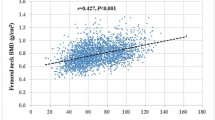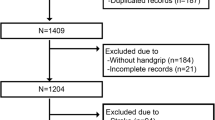Abstract
Summary
Association between strength of nonadjacent muscles and bone mineral density is unclear. We used data from the National Health and Nutrition Examination Survey to convince the effect of grip strength on femoral neck and lumbar spine mineral density in the general US population. This research can broaden the area of muscle-bone interaction.
Introduction
Grip test measures the maximum isotonic strength of hand and forearm and is often used as an indicator of general muscle strength. Muscle has been shown to exert positive effects on bone health, and studies are needed to test whether grip strength can be associated with bone mineral density of nonadjacent bones. The aim of this study is to assess whether grip strength is an independent predictor for bone mineral density (BMD) of femoral neck and total lumbar spine in the general US population.
Methods
We used the data from the National Health and Nutrition Examination Survey (NHANES) 2013–2014, and 1850 participants aged from 40 to 80 years old were included in the analysis. Grip strength was recorded as the largest reading of three efforts of one’s dominant hand using a handgrip dynamometer. Femoral neck and lumbar spine BMDs were measured through Dual-energy X-ray absorptiometry (DXA) scan. Univariate and multivariate linear regression analyses were done to examine the association between grip strength and BMDs.
Results
After adjusting for age, ethnicity, body mass index (BMI), use of female hormones, smoking habit, drinking habit, family history of osteoporosis, use of calcium and vitamin D supplements, physical activity, serum calcium, and phosphorus levels, grip strength is associated with increased femoral neck and total lumbar spine BMDs in men (P < 0.001, P = 0.005), premenopausal women (P = 0.040, P = 0.014), and postmenopausal women (P = 0.016, P = 0.012).
Conclusions
Our results suggest that (1) grip strength can be associated with BMD of nonadjacent bones, and (2) grip strength of dominant hand can be an indicator of BMD in the general US population across genders and menopausal status.
Similar content being viewed by others
References
Wright NC, Saag KG, Dawson-Hughes B, Khosla S, Siris ES (2017) The impact of the new National Bone Health Alliance (NBHA) diagnostic criteria on the prevalence of osteoporosis in the USA. Osteoporos Int 28(4):1225–1232
Melton LJ 3rd et al (1992) Perspective. How many women have osteoporosis? J Bone Miner Res 7(9):1005–1010
Cummings SR, Nevitt MC, Browner WS, Stone K, Fox KM, Ensrud KE, Cauley J, Black D, Vogt TM (1995) Risk factors for hip fracture in white women. Study of osteoporotic fractures research group. N Engl J Med 332(12):767–773
Ho-Pham LT, Nguyen UD, Nguyen TV (2014) Association between lean mass, fat mass, and bone mineral density: a meta-analysis. J Clin Endocrinol Metab 99(1):30–38
Guo B, Zhang ZK, Liang C, Li J, Liu J, Lu A, Zhang BT, Zhang G (2017) Molecular communication from skeletal muscle to bone: a review for muscle-derived myokines regulating bone metabolism. Calcif Tissue Int 100(2):184–192
Colaianni G, Mongelli T, Colucci S, Cinti S, Grano M (2016) Crosstalk between muscle and bone via the muscle-myokine irisin. Curr Osteoporos Rep 14(4):132–137
Norman K et al (2011) Hand grip strength: outcome predictor and marker of nutritional status. Clin Nutr 30(2):135–142
Bohannon RW (2015) Muscle strength: clinical and prognostic value of hand-grip dynamometry. Curr Opin Clin Nutr Metab Care 18(5):465–470
Bevier WC, Wiswell RA, Pyka G, Kozak KC, Newhall KM, Marcus R (1989) Relationship of body composition, muscle strength, and aerobic capacity to bone mineral density in older men and women. J Bone Miner Res 4(3):421–432
Henderson NK, Price RI, Cole JH, Gutteridge DH, Bhagat CI (1995) Bone density in young women is associated with body weight and muscle strength but not dietary intakes. J Bone Miner Res 10(3):384–393
Thorsen K, Nordström P, Lorentzon R, Dahlén GH (1999) The relation between bone mineral density, insulin-like growth factor I, lipoprotein (a), body composition, and muscle strength in adolescent males. J Clin Endocrinol Metab 84(9):3025–3029
Blain H, Vuillemin A, Teissier A, Hanesse B, Guillemin F, Jeandel C (2001) Influence of muscle strength and body weight and composition on regional bone mineral density in healthy women aged 60 years and over. Gerontology 47(4):207–212
Gerdhem P, Ringsberg KA, Akesson K, Obrant KJ (2003) Influence of muscle strength, physical activity and weight on bone mass in a population-based sample of 1004 elderly women. Osteoporos Int 14(9):768–772
Ribom E, Ljunggren O, Piehl-Aulin K, Ljunghall S, Bratteby LE, Samuelson G, Mallmin H (2004) Muscle strength correlates with total body bone mineral density in young women but not in men. Scand J Med Sci Sports 14(1):24–29
Pang MY, Eng JJ (2005) Muscle strength is a determinant of bone mineral content in the hemiparetic upper extremity: implications for stroke rehabilitation. Bone 37(1):103–111
Liang MT, Bassin S, Dutto D, Braun W, Wong N, Pontello AM, Cooper DM, Arnaud SB (2007) Bone mineral density and leg muscle strength in young Caucasian, Hispanic, and Asian women. J Clin Densitom 10(2):157–164
Rikkonen T, Sirola J, Salovaara K, Tuppurainen M, Jurvelin JS, Honkanen R, Kröger H (2012) Muscle strength and body composition are clinical indicators of osteoporosis. Calcif Tissue Int 91(2):131–138
Matsui Y, Takemura M, Harada A, Ando F, Shimokata H (2014) Effects of knee extensor muscle strength on the incidence of osteopenia and osteoporosis after 6 years. J Bone Miner Metab 32(5):550–555
Ahedi H, Aitken D, Scott D, Blizzard L, Cicuttini F, Jones G (2014) The association between hip muscle cross-sectional area, muscle strength, and bone mineral density. Calcif Tissue Int 95(1):64–72
Pasco JA et al (2015) Muscle strength and areal bone mineral density at the hip in women: a cross-sectional study. BMC Musculoskelet Disord 16:124
Sirola J et al (2008) Grip strength may facilitate fracture prediction in perimenopausal women with normal BMD: a 15-year population-based study. Calcif Tissue Int 83(2):93–100
Kaya A, Ozgocmen S, Ardicoglu O, Kamanli A, Gudul H (2005) Relationship between grip strength and hand bone mineral density in healthy adults. Arch Med Res 36(5):603–606
Osei-Hyiaman D et al (1999) Influence of grip strength on metacarpal bone mineral density in postmenopausal Japanese women: a cross-sectional study. Calcif Tissue Int 64(3):263–266
Chan DC, Lee WT, Lo DH, Leung JC, Kwok AW, Leung PC (2008) Relationship between grip strength and bone mineral density in healthy Hong Kong adolescents. Osteoporos Int 19(10):1485–1495
Nasri R, Hassen Zrour S, Rebai H, Fadhel Najjar M, Neffeti F, Bergaoui N, Mejdoub H, Tabka Z (2013) Grip strength is a predictor of bone mineral density among adolescent combat sport athletes. J Clin Densitom 16(1):92–97
Aydin G, Atalar E, Keleş I, Tosun A, Zöğ G, Keleş H, Orkun S (2006) Predictive value of grip strength for bone mineral density in males: site specific or systemic? Rheumatol Int 27(2):125–129
Dixon WG, Lunt M, Pye SR, Reeve J, Felsenberg D, Silman AJ, O'Neill TW, European Prospective Osteoporosis Study Group (2005) Low grip strength is associated with bone mineral density and vertebral fracture in women. Rheumatology (Oxford) 44(5):642–646
Kritz-Silverstein D, Barrett-Connor E (1994) Grip strength and bone mineral density in older women. J Bone Miner Res 9(1):45–51
Lau EM et al (1993) Low bone mineral density, grip strength and skinfold thickness are important risk factors for hip fracture in Hong Kong Chinese. Osteoporos Int 3(2):66–70
Johnell O, Kanis J (2005) Epidemiology of osteoporotic fractures. Osteoporos Int 16(Suppl 2):S3–S7
Taaffe DR, Cauley JA, Danielson M, Nevitt MC, Lang TF, Bauer DC, Harris TB (2001) Race and sex effects on the association between muscle strength, soft tissue, and bone mineral density in healthy elders: the health, aging, and body composition study. J Bone Miner Res 16(7):1343–1352
Sahin G, Duce MN, Milcan A, Bagis S, Cimen OB, Cimen B, Erdogan C (2002) Bone mineral density and grip strength in postmenopausal Turkish women with osteoporosis: site specific or systemic? Int J Fertil Womens Med 47(5):236–239
Fujita K, Kaburagi H, Nimura A, Miyamoto T, Wakabayashi Y, Seki Y, Aoyama H, Shimura H, Kato R, Okawa A (2019) Lower grip strength and dynamic body balance in women with distal radial fractures. Osteoporos Int 30(5):949–956
Naka H, Iki M, Morita A, Ikeda Y (2005) Effects of pubertal development, height, weight, and grip strength on the bone mineral density of the lumbar spine and hip in peripubertal Japanese children: Kyoto kids increase density in the skeleton study (Kyoto KIDS study). J Bone Miner Metab 23(6):463–469
Sirola J et al (2005) Associations between grip strength change and axial postmenopausal bone loss--a 10-year population-based follow-up study. Osteoporos Int 16(12):1841–1848
Foley KT et al (1999) Maximum grip strength is not related to bone mineral density of the proximal femur in older adults. Calcif Tissue Int 64(4):291–294
Goodman CA, Hornberger TA, Robling AG (2015) Bone and skeletal muscle: key players in mechanotransduction and potential overlapping mechanisms. Bone 80:24–36
Pedersen BK, Febbraio MA (2012) Muscles, exercise and obesity: skeletal muscle as a secretory organ. Nat Rev Endocrinol 8(8):457–465
Kaji H (2016) Effects of myokines on bone. Bonekey Rep 5:826
Author information
Authors and Affiliations
Corresponding author
Ethics declarations
Conflict of interest
None.
Additional information
Publisher’s note
Springer Nature remains neutral with regard to jurisdictional claims in published maps and institutional affiliations.
Rights and permissions
About this article
Cite this article
Luo, Y., Jiang, K. & He, M. Association between grip strength and bone mineral density in general US population of NHANES 2013–2014. Arch Osteoporos 15, 47 (2020). https://doi.org/10.1007/s11657-020-00719-2
Received:
Accepted:
Published:
DOI: https://doi.org/10.1007/s11657-020-00719-2




